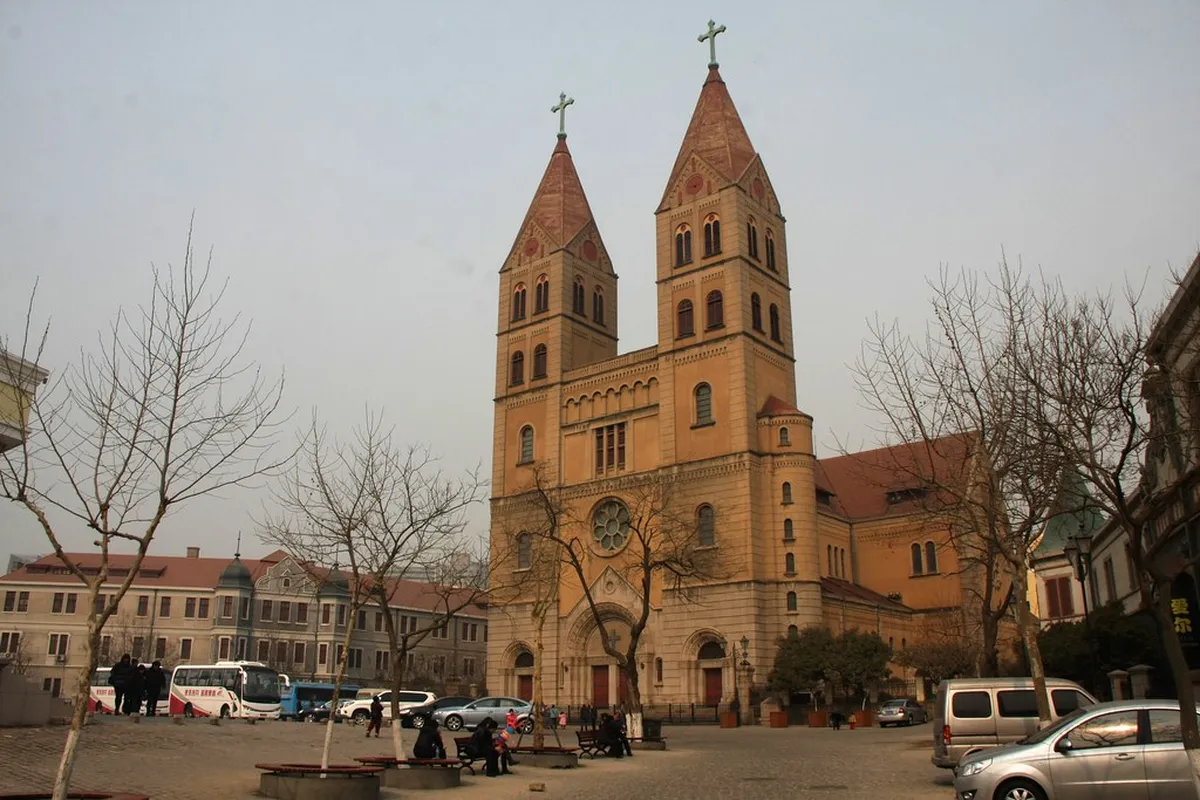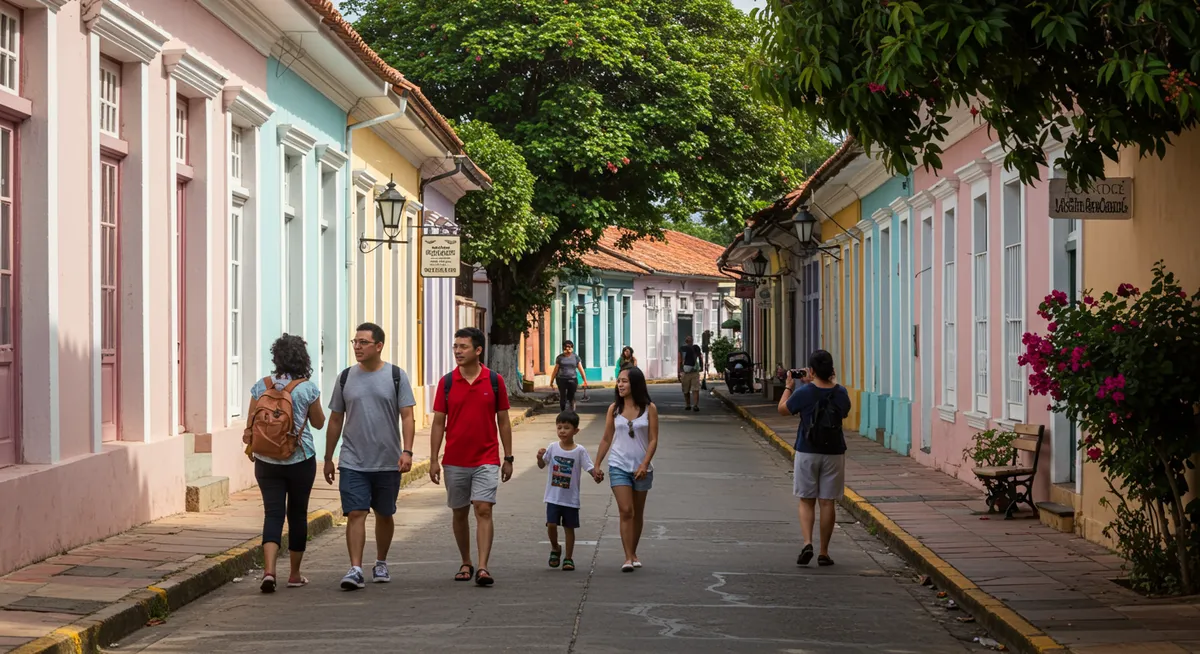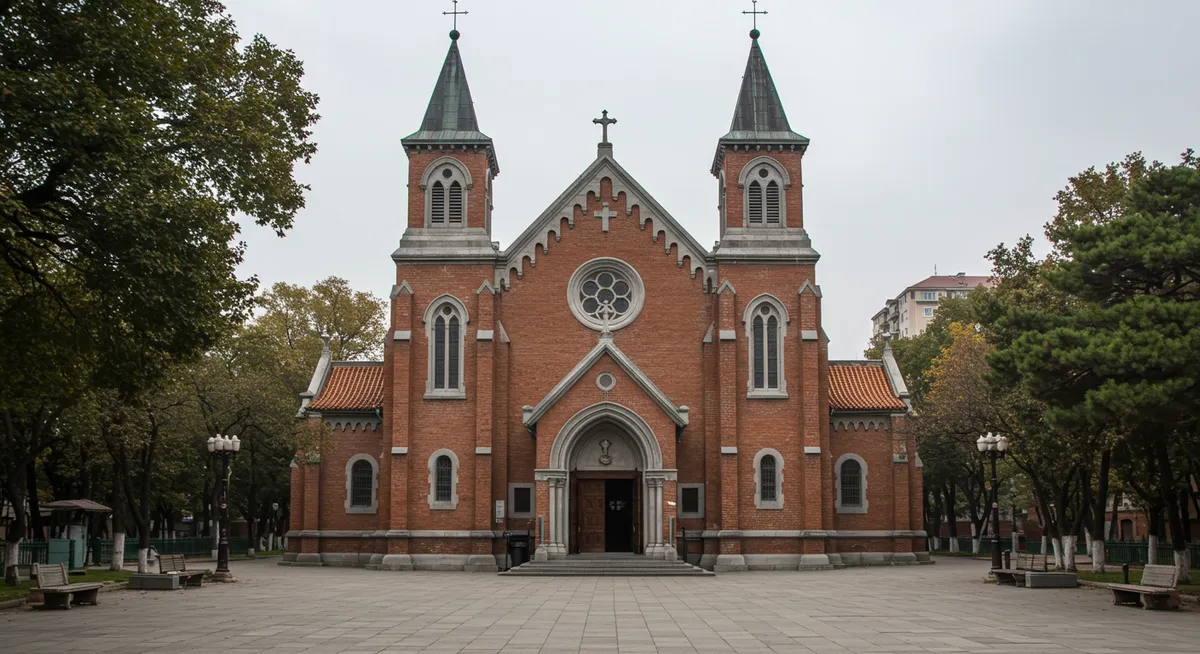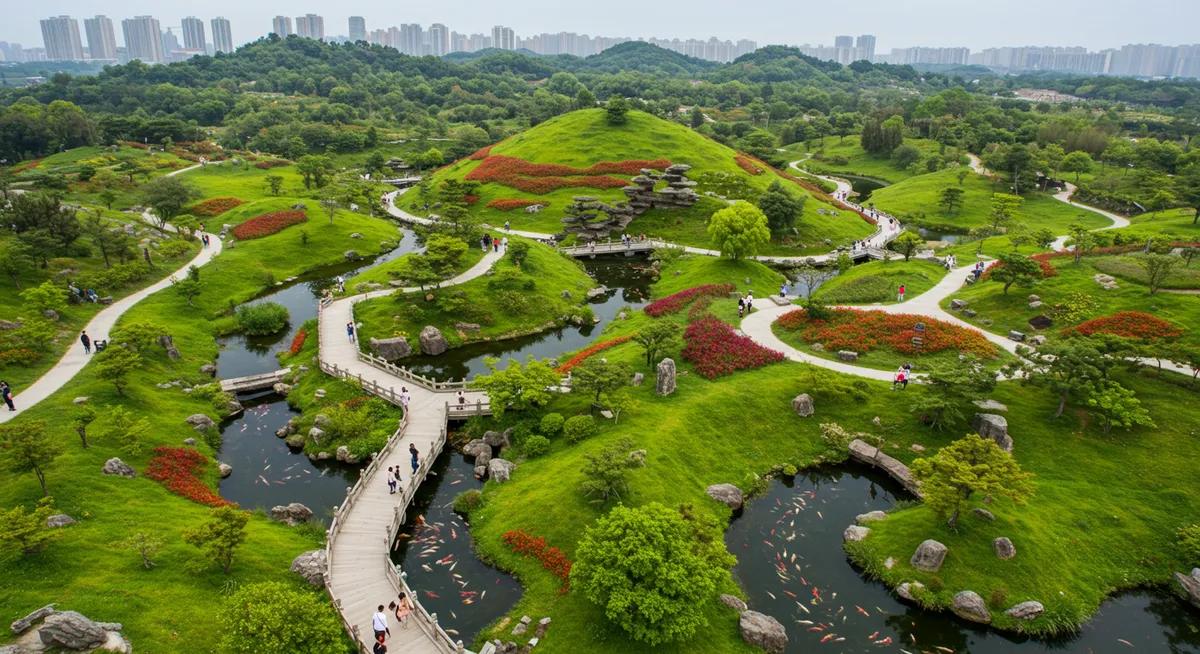St. Michael's Cathedral Qingdao: Gothic Revival Architecture & Sacred Heritage
St. Michael's Cathedral stands as Qingdao's most recognizable religious landmark, combining soaring Gothic Revival architecture with active Catholic worship to create a spiritual and cultural destination that represents the enduring legacy of German colonial influence while serving the vibrant faith community of modern Qingdao. This comprehensive guide explores the cathedral's architectural magnificence, religious significance, historical context, and practical information for experiencing this sacred space that bridges centuries of cultural exchange and spiritual devotion. Whether drawn by architectural interest, religious significance, or cultural curiosity, St. Michael's Cathedral offers profound experiences that deepen understanding of Qingdao's multicultural heritage and continuing spiritual traditions in this remarkable coastal city.

Cathedral Overview and Significance
Plan this trip faster with our free online itinerary maker. Get a personalized day-by-day plan in minutes.
Built between 1932-1934 during the height of Qingdao's international development, St. Michael's Cathedral represents the culmination of Gothic Revival church architecture in East Asia, designed by German architect Arthur Druwe to serve the growing Catholic community while creating an architectural landmark that would endure as a symbol of faith and cultural exchange.
The cathedral's prominent location on elevated ground ensures its twin spires remain visible throughout central Qingdao, serving as navigation landmarks while symbolizing the spiritual aspirations of the community. Its active role as both worship center and cultural monument demonstrates successful preservation of religious heritage within modern urban development.
St. Michael's Cathedral continues serving as the center of Catholic life in Qingdao while welcoming visitors of all backgrounds who appreciate architectural beauty, historical significance, and spiritual atmosphere. This dual role creates dynamic environments where sacred purpose and cultural education coexist harmoniously.
Gothic Revival Architecture
Architectural Design and Features
Exterior Gothic Elements:
- Twin Spires: 60-meter towers creating dramatic vertical emphasis
- Rose Window: Large circular stained glass window above main entrance
- Flying Buttresses: Structural supports demonstrating Gothic engineering principles
- Pointed Arches: Classic Gothic arch forms throughout exterior design
- Stone Tracery: Decorative stonework in windows and architectural details
- Pinnacles and Crockets: Ornamental spire decorations emphasizing verticality
Construction Materials and Techniques:
- Local Granite: Qingdao granite providing structural strength and weather resistance
- German Engineering: Advanced construction techniques for seismic stability
- Imported Elements: Selected architectural details sourced from Europe
- Modern Adaptations: Engineering modifications for Chinese climate conditions
- Restoration Materials: Ongoing conservation using period-appropriate materials
- Craftsmanship Quality: High-quality stonework and construction details
Interior Architecture and Sacred Spaces
Nave and Sanctuary Design:
- Vaulted Ceilings: Gothic ribbed vaulting creating soaring interior spaces
- Clerestory Windows: Upper windows flooding interior with natural light
- Altar Design: Traditional Catholic altar with Gothic Revival decorative elements
- Pew Arrangement: Traditional seating accommodating congregation worship
- Processional Space: Central aisle designed for liturgical processions
- Side Chapels: Smaller worship spaces for intimate prayer and devotion
Stained Glass and Artistic Elements:
- Rose Window: Central stained glass window with religious iconography
- Side Windows: Narrative stained glass depicting religious scenes
- Color Symbolism: Traditional Catholic color meanings in glass design
- Light Effects: Changing light patterns throughout daily worship cycles
- Artistic Quality: High-quality craftsmanship in religious art
- Cultural Integration: Some elements reflecting Chinese artistic influences
Religious Life and Services
Catholic Worship and Community
Regular Religious Services:
- Daily Mass: Weekday morning services for regular congregants
- Sunday Services: Multiple Sunday masses accommodating community needs
- Holy Day Celebrations: Special services for Catholic holy days and feast days
- Seasonal Liturgies: Christmas, Easter, and other seasonal religious observances
- Language Options: Services conducted in Chinese with some multilingual elements
- Youth Programs: Religious education and youth ministry activities
Community Activities and Programs:
- Religious Education: Classes for children and adult faith formation
- Charitable Works: Community service and outreach programs
- Cultural Events: Religious festivals and cultural celebrations
- Music Ministry: Choir and musical programs enhancing worship
- International Community: Services for international Catholic residents
- Interfaith Dialogue: Programs promoting religious understanding
Visitor Accommodation and Guidelines
Visitor Policies and Etiquette:
- Respectful Behavior: Quiet, reverent conduct during visits
- Photography Guidelines: Restricted photography during religious services
- Dress Code: Modest clothing appropriate for sacred space
- Service Participation: Visitors welcome to observe worship respectfully
- Cultural Sensitivity: Understanding Catholic traditions and customs
- Guided Information: Available information about cathedral significance
Historical Context and Development
🌟 Local Expert Tip: Get the most out of your Culture visit with guided tours!
German Colonial Period and Construction
Colonial Religious Development:
- Catholic Mission History: Early Catholic presence in Qingdao region
- German Colonial Support: Official support for religious construction
- Community Growth: Expanding Catholic population requiring permanent church
- Architectural Competition: Selection process for cathedral design
- Construction Challenges: Engineering and logistical challenges of period
- Dedication and Consecration: Official opening and religious dedication
Architect Arthur Druwe and Design Vision:
- Architectural Background: Druwe's experience with Gothic Revival design
- Design Philosophy: Balancing European traditions with local conditions
- Technical Innovation: Modern engineering within traditional aesthetic
- Cultural Adaptation: Accommodating Chinese cultural and climatic considerations
- Legacy Achievement: Creating enduring architectural landmark
- Professional Recognition: Druwe's contribution to Qingdao architecture
20th Century Challenges and Preservation
Historical Periods and Changes:
- Japanese Occupation: Changes in religious administration and use
- Chinese Civil War: Challenges to religious institutions and communities
- Cultural Revolution: Period of reduced religious activity and building stress
- Reform and Opening: Restoration of religious freedom and building renovation
- Modern Preservation: Government protection as historical and cultural monument
- Current Status: Active religious use with heritage protection
Architecture and Art Appreciation
Detailed Architectural Analysis
Gothic Revival Style Elements:
- Structural System: Gothic engineering principles adapted for Chinese conditions
- Proportional Harmony: Classical Gothic proportions creating visual balance
- Vertical Emphasis: Spires and vertical elements drawing eyes skyward
- Light Integration: Window placement maximizing natural light effects
- Decorative Program: Ornamental elements supporting spiritual symbolism
- Cultural Synthesis: European style adapted for Chinese cultural context
Symbolic and Spiritual Elements:
- Orientation: Traditional east-west church orientation for liturgical purposes
- Sacred Geometry: Proportional relationships reflecting spiritual beliefs
- Iconographic Program: Religious symbols and artistic elements
- Processional Design: Spatial organization supporting liturgical movement
- Acoustic Properties: Design supporting musical and spoken word
- Contemplative Spaces: Areas designed for prayer and meditation
Artistic Heritage and Decoration
Stained Glass Artistry:
- Religious Narratives: Biblical scenes and religious stories depicted in glass
- Color Symbolism: Traditional Catholic color meanings and associations
- Artistic Technique: Traditional stained glass construction methods
- Light Transformation: Natural light filtered through colored glass
- Seasonal Effects: Changing light patterns throughout year
- Restoration Care: Ongoing conservation of artistic elements
Photography and Documentation
Architectural Photography Opportunities
Exterior Photography:
- Facade Compositions: Full facade shots showing complete architectural design
- Spire Details: Close-up shots of tower architecture and decorative elements
- Contextual Views: Cathedral within surrounding urban environment
- Seasonal Variations: Same architectural elements across different seasons
- Lighting Studies: Different times of day and lighting conditions
- Detail Photography: Stone carving, windows, and architectural details
Interior Photography Guidelines:
- Permission Required: Check with cathedral staff before interior photography
- Service Restrictions: No photography during religious services
- Respectful Approach: Non-flash photography to avoid disruption
- Architectural Focus: Emphasis on architectural rather than personal photography
- Artistic Elements: Stained glass, altar, and artistic details
- Cultural Sensitivity: Respectful documentation of sacred space
Best Photography Times and Conditions
Optimal Lighting Conditions:
- Golden Hour: Late afternoon light warming stone facades
- Overcast Days: Even lighting reducing harsh shadows
- Blue Hour: Evening twilight with interior lighting visible
- Clear Days: Sharp contrast and definition in architectural details
- Seasonal Light: Different sun angles throughout year
- Weather Drama: Storm clouds creating dramatic sky backgrounds
Cultural and Educational Value
Religious Education and Understanding
Catholic Heritage and Traditions:
- Liturgical Understanding: Education about Catholic worship and traditions
- Architectural Symbolism: Religious meanings in Gothic design elements
- Historical Context: Catholic missions and cultural exchange in China
- Interfaith Dialogue: Promoting understanding between religious traditions
- Cultural Bridge: Cathedral as symbol of international cooperation
- Educational Programs: Tours and educational materials for visitors
Architectural and Cultural Education:
- Gothic Revival Style: Understanding architectural movement and principles
- Construction Techniques: Traditional building methods and modern adaptations
- Cultural Synthesis: European and Chinese elements in religious architecture
- Preservation Science: Conservation techniques for historic buildings
- Urban Planning: Religious buildings within city development
- International Architecture: German architectural influence in China
Visiting Information and Guidelines
Access and Transportation
Location and Access:
- Central Location: Easily accessible from major Qingdao hotels and attractions Need extra inspiration for Qingdao? Check Qingdao qingdao guide for insider ideas.
- Walking Distance: 5-minute walk from Little Fish Hill and Signal Hill
- Public Transport: Multiple bus routes serve the cathedral area
- Taxi Access: Direct taxi service to cathedral entrance
- Metro Connection: Short walk from Line 3 stations
- Pedestrian-Friendly: Safe walking routes through historic district
For comprehensive transportation information, consult our detailed transport guide.
Parking and Vehicle Access:
- Limited Parking: Very limited parking near cathedral
- Street Parking: Some street parking in surrounding historic area
- Public Transport Recommended: Walking or public transport preferred
- Traffic Restrictions: Some streets restricted during religious services
- Alternative Parking: Parking areas in nearby commercial districts
Visiting Hours and Service Times
General Visiting Information:
- Visiting Hours: Generally open during daylight hours for visitors
- Service Times: Check current schedule for mass times
- Holy Days: Extended hours during major religious celebrations
- Private Events: Occasional closures for special religious ceremonies
- Guided Tours: Available by arrangement with cathedral administration
- Group Visits: Advance booking recommended for large groups
Visitor Etiquette and Cultural Sensitivity
Respectful Visiting Guidelines
Appropriate Behavior:
- Quiet Reverence: Maintain quiet, respectful behavior throughout visit
- Religious Respect: Honor ongoing worship and religious activities
- Modest Dress: Dress appropriately for sacred space visit Explore related insights at Qingdao experiences.
- Photography Etiquette: Follow photography guidelines and restrictions
- Service Observation: Visitors may observe services respectfully
- Cultural Understanding: Appreciate religious significance and traditions
International Visitor Considerations:
- Language Assistance: Basic English information available
- Cultural Orientation: Information about Catholic traditions and customs
- Religious Diversity: Welcoming atmosphere for visitors of all backgrounds
- Educational Focus: Architectural and cultural education for non-Catholics
- Interfaith Respect: Mutual respect between different religious traditions
- Tourist Accommodation: Understanding visitor interest and needs
Special Events and Celebrations
Religious Calendar and Celebrations
Major Religious Observances:
- Christmas Celebrations: Special masses and holiday decorations
- Easter Services: Holy Week and Easter Sunday celebrations
- Catholic Holy Days: Special observances throughout liturgical year
- Patron Saint Festival: Annual celebration of St. Michael
- First Communion: Special ceremonies for Catholic children
- Wedding Ceremonies: Traditional Catholic wedding services
Cultural and Community Events:
- Music Concerts: Sacred music performances and concerts
- Cultural Festivals: Religious and cultural celebration events
- Educational Programs: Lectures and educational events
- Interfaith Events: Programs promoting religious understanding
- Art Exhibitions: Religious art and cultural exhibitions
- Community Service: Charitable activities and community outreach
Combining with Other Qingdao Attractions
🎯 Insider Tip: Discover the best Culture experiences with Viator Tours!
Historic District Exploration
Walking Tour Combinations:
- German Architecture Tour: St. Michael's + Little Fish Hill + German district
- Religious Heritage: St. Michael's + Protestant Church comparison
- Hill Views Tour: Cathedral + Signal Hill + viewpoints
- Cultural Heritage: Cathedral + Badaguan + colonial architecture
- Historic Center: Cathedral + Zhanqiao + old town exploration
Photography and Architecture Tours:
- Architecture Focus: Multiple architectural styles within walking distance
- Photography Circuit: Different viewpoints and architectural subjects
- Cultural Documentation: Religious and cultural heritage sites
- Historical Timeline: Buildings representing different historical periods
- International Architecture: German, Chinese, and modern architectural comparison
Conservation and Future Preservation
Ongoing Preservation Efforts
Conservation Programs:
- Structural Maintenance: Ongoing engineering assessment and maintenance
- Artistic Conservation: Stained glass and decorative element preservation
- Weather Protection: Climate control and weather damage prevention
- Heritage Documentation: Detailed recording of architectural and artistic elements
- Professional Restoration: Specialist conservation work when needed
- Funding Sources: Government and community support for preservation
Cultural Heritage Protection:
- Legal Protection: Government designation as protected cultural monument
- Community Support: Local and international interest in preservation
- Educational Value: Recognition of cathedral's cultural and educational significance
- Tourism Contribution: Economic value supporting preservation efforts
- International Cooperation: German-Chinese collaboration in preservation
- Future Planning: Long-term preservation strategy and planning
St. Michael's Cathedral represents more than architectural achievement; it embodies successful cultural exchange and religious tolerance that defines modern Qingdao's character. The cathedral's continuing role as both active worship center and cultural landmark demonstrates how historical preservation and contemporary community needs can coexist harmoniously.
Integrate cathedral visits into broader Qingdao exploration using our comprehensive itineraries, and discover how this magnificent Gothic Revival landmark enhances understanding of the cultural diversity and religious heritage that contribute to Qingdao's unique identity as an international coastal city.



